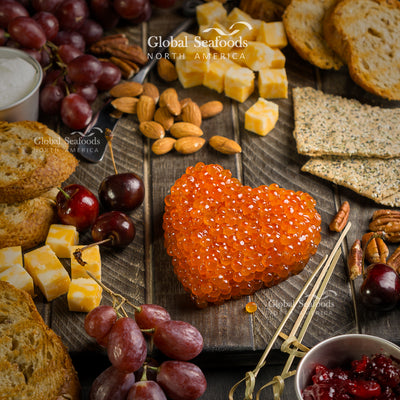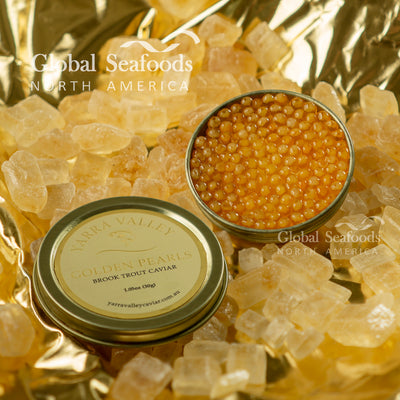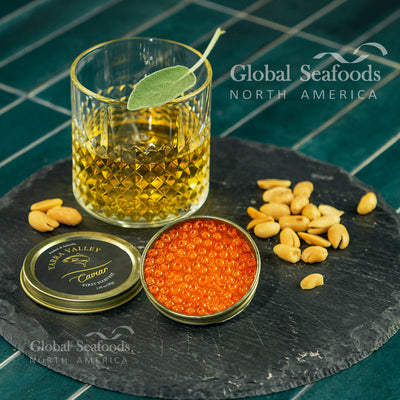How to Make Ikura Onigiri: A Simple and Tasty Snack

Make Ikura Onigiri: Recipe
Onigiri, or Japanese rice balls, are a staple of Japanese cuisine. They are simple, convenient, and endlessly versatile. But one variation stands out for its unique flavor and luxurious texture: Ikura Onigiri. Filled with ikura (salmon roe), these rice balls offer a briny, rich taste that perfectly complements the slightly seasoned rice. Whether you're looking for a quick snack, a lunchbox addition, or a way to impress at a gathering, Ikura Onigiri is a fantastic choice.
In this detailed guide, we will walk you through the step-by-step process of making Ikura Onigiri, share tips for sourcing the freshest ikura, and offer insights into why this snack is both delicious and nutritious.
What Is Ikura Onigiri?
Onigiri is one of Japan's most beloved snacks, traditionally made by forming seasoned rice into a triangular or cylindrical shape, sometimes with a filling and often wrapped in nori (seaweed). Ikura Onigiri specifically uses ikura—bright orange salmon roe—as its filling. The burst of briny flavor from the roe combined with the soft, slightly sticky rice creates an irresistible snack that is as nutritious as it is flavorful.
Chef Nobu Matsuhisa, an expert in Japanese cuisine, once said, "Simplicity is the key to brilliance." This sentiment rings true for Ikura Onigiri, where the freshest ingredients shine through in a simple, unpretentious format.
Why Ikura Onigiri is the Perfect Snack
Ikura Onigiri offers a balance of protein, healthy fats, and carbohydrates, making it not only delicious but also nourishing. The salmon roe is packed with omega-3 fatty acids, which are known for their heart health benefits, while the rice provides a slow-release energy source. It’s a snack that’s perfect for busy days when you need a quick yet satisfying bite.
Furthermore, making Ikura Onigiri at home allows you to control the ingredients, ensuring that your snack is fresh, free from preservatives, and tailored to your tastes.
Ingredients for Ikura Onigiri
Here’s what you’ll need to make 4-6 servings of Ikura Onigiri.
Main Ingredients:
- 2 cups of Japanese short-grain rice
- 4 oz ikura (salmon roe) – High-quality ikura can be sourced from Global Seafoods
- 1-2 sheets of nori (dried seaweed), cut into strips
- 1 tablespoon rice vinegar
- 1 teaspoon salt
- 1 teaspoon sugar
- Water for shaping the rice
Optional Garnishes:
- Toasted sesame seeds
- Chopped green onions
- Soy sauce for dipping
For premium salmon roe options, consider trying Chum Salmon Caviar or Coho Salmon Caviar from Global Seafoods. Their sustainably sourced ikura is perfect for this recipe.
How to Make Ikura Onigiri: Step-by-Step Guide
Step 1: Prepare the Rice
The base of any good onigiri is perfectly cooked Japanese short-grain rice. Follow these steps for optimal results:
- Rinse the rice under cold water until the water runs clear to remove excess starch.
- Cook the rice in a rice cooker or on the stove, using the ratio of 1 cup of rice to 1.1 cups of water.
- Once cooked, gently mix the rice with rice vinegar, salt, and sugar. The vinegar adds a subtle flavor and helps preserve the rice, while the salt and sugar balance out the taste.
Step 2: Prepare Your Filling
While the rice cools slightly, prepare your ikura filling. The ikura should be fresh and cold to contrast with the warm rice. If your ikura needs a boost in flavor, you can lightly marinate it in a mixture of soy sauce and mirin for 10-15 minutes.
Pro Tip: For an even richer experience, consider mixing in other types of roe like Golden Pearls Brook Trout Caviar for a unique flavor blend.
Step 3: Shaping the Onigiri
Now comes the fun part—shaping your onigiri.
- Wet your hands with water to prevent the rice from sticking, and sprinkle a little salt on your palms.
- Take a handful of rice (about 1/3 cup) and flatten it slightly in your palm.
- Place a small spoonful of ikura in the center.
- Gently fold the rice over the ikura, forming it into a triangular or round shape. Be careful not to press too hard, as the ikura is delicate and can burst.
Chef’s Note: “The art of onigiri is in the touch,” says chef Morimoto, emphasizing that the rice should be compact but not overly pressed.
Step 4: Add Nori and Garnishes
Once your onigiri is shaped, wrap a strip of nori around the bottom for texture and flavor. The nori will provide a satisfying crunch that complements the softness of the rice and ikura.
For added flavor and presentation, you can sprinkle toasted sesame seeds or chopped green onions over the top. A small drizzle of soy sauce also pairs beautifully with the salmon roe.
Where to Buy the Best Ikura for Onigiri
The quality of the ikura you use is critical for making delicious Ikura Onigiri. Fresh ikura has a firm texture and a bright, briny flavor that enhances the rice. If you’re looking to buy high-quality ikura online, Global Seafoods offers an excellent selection. Their Pink Salmon Caviar and Trout Red Caviar are also great options for those who want to try different varieties of roe.
For more ideas and tips, check out Global Seafoods’ YouTube Channel, which features videos on preparing seafood and creative recipe ideas.
Why Ikura is a Nutritional Powerhouse
Ikura isn’t just a tasty treat—it’s packed with nutrients that make it a healthy choice. Here’s why you should consider adding more ikura to your diet:
1. High in Omega-3 Fatty Acids
Salmon roe is an excellent source of omega-3 fatty acids, which have been shown to promote heart health and reduce inflammation. According to the American Heart Association, omega-3s can help lower blood pressure and reduce the risk of heart disease.
2. Rich in Protein
Each serving of ikura provides a healthy dose of high-quality protein, making it a great addition to a balanced diet. Protein is essential for building and repairing tissues, and it also helps you feel fuller for longer.
3. Packed with Vitamins and Minerals
Ikura is rich in vitamins A, D, and B12, as well as key minerals like phosphorus and selenium. These nutrients support everything from bone health to immune function.
Frequently Asked Questions About Making Ikura Onigiri
1. Can I freeze ikura for later use?
Yes, ikura can be frozen for up to three months if stored in an airtight container. However, freezing may slightly alter its texture. Thaw the ikura slowly in the refrigerator for the best results.
2. How long does ikura last in the fridge?
Fresh ikura will last 3-4 days in the fridge when stored in an airtight container. To preserve its freshness, keep it cold and avoid exposing it to air.
3. Can I substitute other types of roe in this recipe?
Absolutely! If you can’t find ikura, you can use other types of roe such as Rainbow Trout Pearls or Bloody Shiraz Infused Caviar. Each type of roe will bring its own unique flavor profile to the dish.
4. What kind of rice should I use for onigiri?
It’s important to use Japanese short-grain rice (sometimes labeled as sushi rice) for onigiri. This type of rice is stickier than long-grain varieties, which helps the onigiri hold its shape.
5. Can I make onigiri in advance?
Yes, you can make onigiri in advance, but it’s best to wrap them in plastic and refrigerate if storing for later. Add the nori right before serving to keep it crisp.
6. Where can I buy high-quality ikura online?
Global Seafoods offers some of the finest ikura and salmon roe products online, all sourced from sustainable fisheries and shipped fresh to your door.
Conclusion: Make Ikura Onigiri Your Next Favorite Snack
Ikura Onigiri is an easy yet elegant snack that highlights the natural flavor of salmon roe. Whether you’re making a quick lunch or preparing snacks for a special occasion, this recipe is a must-try for sushi lovers and home cooks alike. By sourcing high-quality ikura and mastering the art of onigiri, you’ll be able to create a dish that is both satisfying and visually stunning.
For more recipe ideas and tips on preparing seafood, be sure to visit Global Seafoods and subscribe to their YouTube Channel.
Also in Recipes

How to Cook Live Manila Clams at Home: Fresh, Sweet & Delivered Overnight
Discover how to store, clean, and cook Live Manila Clams at home using simple chef techniques. Learn why these Pacific clams are perfect for pasta vongole, steaming, chowders, and more—plus how to order them fresh in a convenient 10 lb bag shipped overnight.

Boiled Crab for Brunch: The Ultimate Guide to Morning Seafood
Discover the joy of Boiled crab for brunch! Learn how to prepare seafood in the morning, its health benefits, and recipes to make your brunch memorable.











